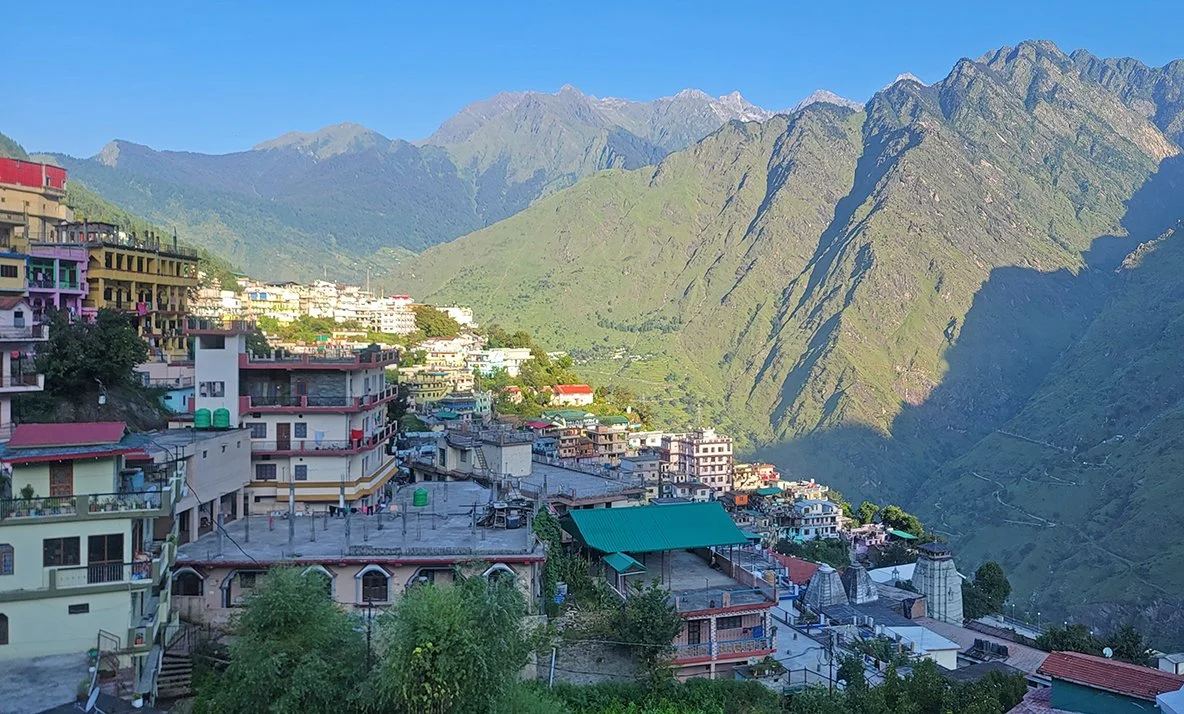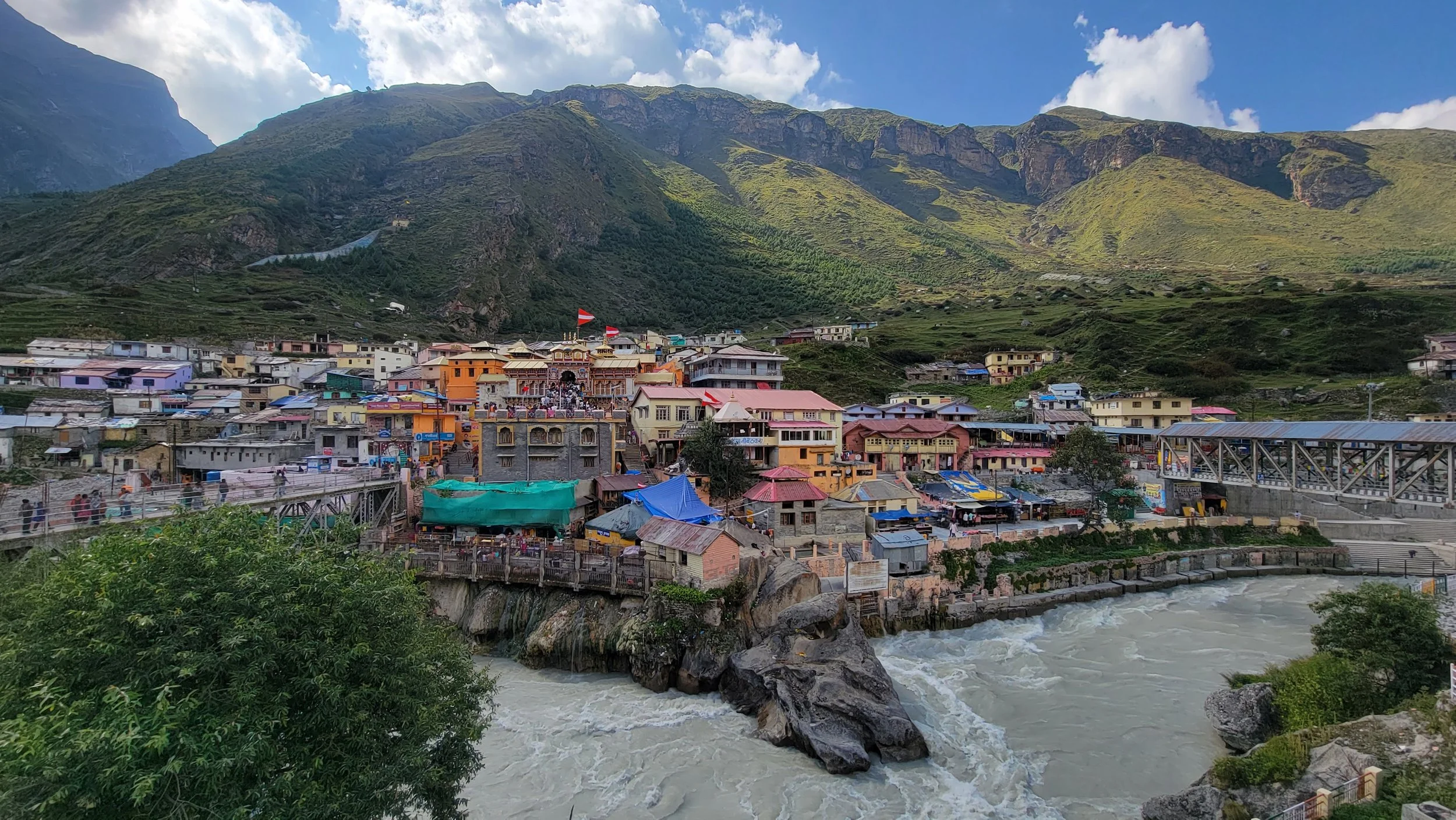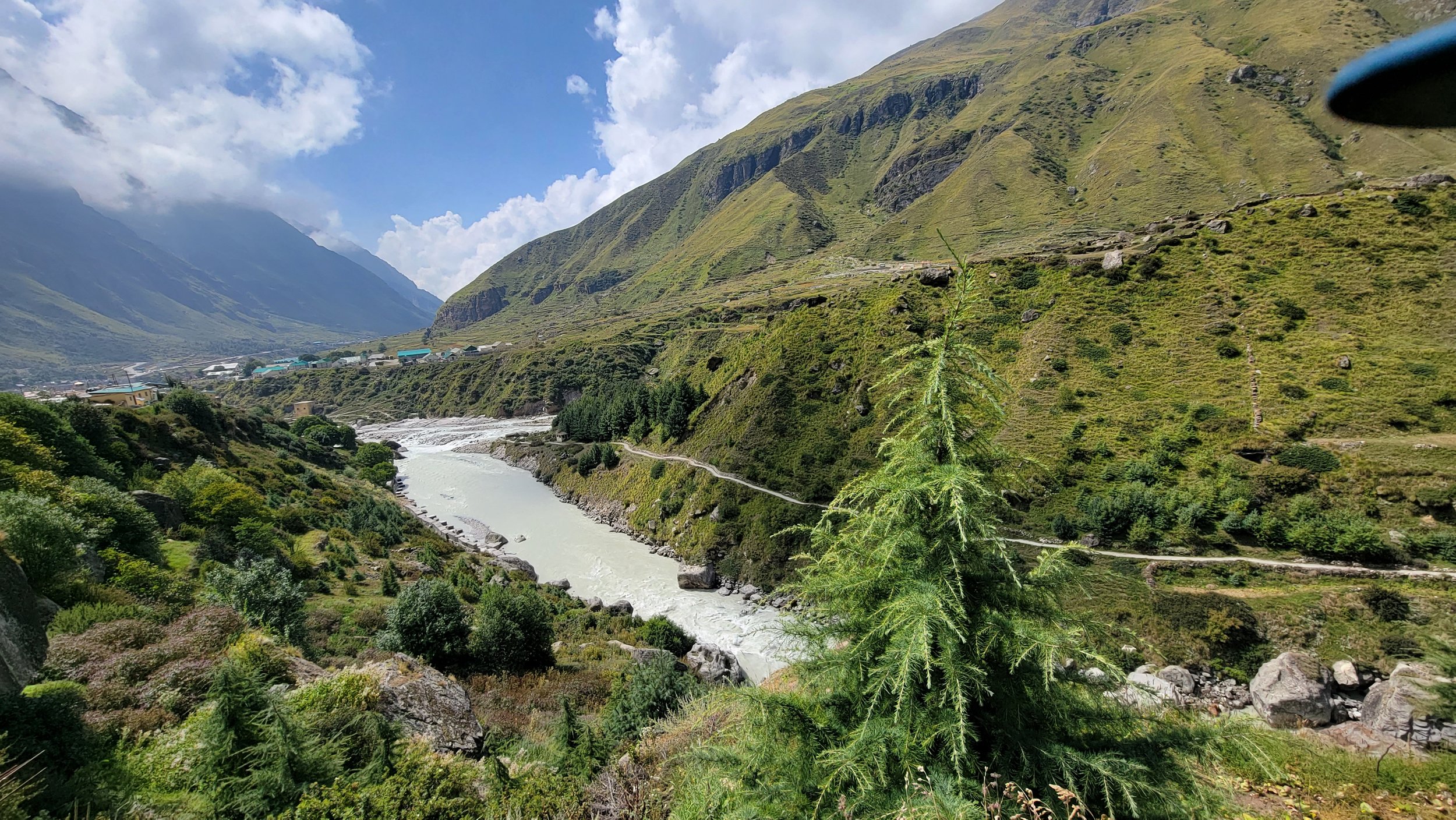The living history in a country like India is constantly shaped by human intervention. If one were to look at ancient temple complexes closely, it would be self-evident that history has been shaped over hundreds, or sometimes thousands of years by the rulers and those in power. And then, there is the sheer might of natural forces which play their part in transmuting every creation of man.
All this was apparent in our travels to the shrines at Joshimath and Badrinath. After our magical time in the solitude of the Dronagiri mountain with Babaji and Lahiri Mahasaya, we entered the chaotic world of mainstream tourism on our way to more popular pilgrimage spots. A long drive from Babaji’s cave brought us to Karnaprayag by late afternoon, when the sun was ruthlessly scorching over the sandy beaches by the Ganges.
Karnaprayag is a sacred river confluence – one of five such confluences between Rishikesh and Badrinath that define the origins of the Ganges. These five prayags (confluences) are holy pilgrimage sites that pilgrims would stop at on their way to the shrines at Badrinath and Kedarnath, and take a dip as part of ritual purification.
View from our hotel rooms in Joshimath
By evening, at the end of a tiring eight-hour drive we reached our hotel in Joshimath, and were impressed by the view of the entire village and the high mountains from our rooms. Joshimath is the gateway to Badrinath, the winter abode of the Lord of Badrinath, when the temple gets covered in snow. It is a small hill town imbued with the sacred vibrations of Adi Shankara (or the first Shankaracharya)
The shrine here was consecrated by Shankara – the entire complex is sanctified by his presence and penance. Shankara became a renunciate at the age of seven and visited Badrinath at the age of eleven! It was part of his “conquest” to establish Vedic religion all over India and to keep other faiths out of the country. He reclaimed the Badrinath temple from Buddhists and retrieved the ancient idol from under the river where it was thrown and consecrated it as the shrine we know today.
With the head priest of the Badrinath temple
Being so remote in those days, he wanted to ensure that the Vedic rituals were followed in the temple through posterity. Hence, he appointed brahmins from the same community as himself from Kerala and established a system through which their descendants would continue to hold the seat of the head priest at Badrinath with the title “Rawal.”
Almost as a miracle, a couple of weeks before we left for India, I was introduced by a friend to a priest at the Badrinath temple. Rakesh, the priest, became a dear friend even before I landed in India and played an instrumental role in making our visit spectacular in every way. It was through him that we got to meet Rawalji (the head priest from Kerala) and receive sacred blessed items directly from him – a divine blessing we did not anticipate.
The highlight of our time in Badrinath was a special early morning service called the Maha Abhishek (or the great ablution) of the Lord. It is a sacred ceremonial washing of the idol of Badrinath and decoration that lasts for over 3 hours. We woke up at 3:30am that morning to shower and prepare ourselves for the experience. When the temple door opened, we were in for a surprise!
We had not imagined how crowded it could possibly get inside the sanctum. This has been one of the busiest times that the temple has ever seen, following the lull of the pandemic. It took us over an hour to find a space and squeeze to be able to finally have direct vision of the sacred idol.
This idol that was rescued and reinstalled by Shankara bears a remarkable resemblance to the image of Babaji that Yogananda presents in the Autobiography of a yogi – a Yogi with a loin cloth, seated in the lotus pose, palms interlocked below the waist and matted hair flowing down his shoulders. It gives new meaning to Yogananda’s statement that Babaji, to this day, lives with his deathless body in the hills above Badrinath.
I was in sheer awe of beholding this ancient image of Babaji preserved and worshipped for thousands of years, whose power and presence has been reigning in this high Himalayan shrine, known to be a sacred place since the Satya yuga.
Milk, and honey, and Ganges water, and sandalwood paste were all used to wash the idol as the priest narrated story after story about Badrinath. The experience was powerful and beyond words. It was as if we had stepped out of this tiny little context of our lives and entered the timeless realm of Narayana, the great Lord of Badri, who has been meditating at this spot since time immemorial, watching over and guiding this planet.
With Rakesh, our priest friend, and the silk garments we purchased for Badrinathji
We were brought back to the mundane realm in our conversations with Rakesh (our priest friend) later that afternoon as he was describing the heart-wrenching plight of his own life and his struggles trying to survive a family by being a priest. The situation there is very precarious with a new development project that is expected to flatten all the shops and structures around the Badrinath temple, threatening the livelihood of Rakesh and many others there, already struggling due to the pandemic and rising prices.
The project is expected to completely reshape the entire town of Badrinath, making it very modern and accessible. My initial response was deep sadness at the loss of the traditional and rustic charm of this beautiful mountain shrine. As I paused, I couldn’t help but think of how many cycles of time the Lord of Badri has witnessed, and is silently affecting this entire planet with the ethereal vibrations of his presence. All that happens in this world is through his will! We bid goodbye to Rakesh with the promise to support him when things get harder.
The town of Badrinath, the temple and the Alaknanda river
The next day before leaving Badrinath, we also visited the tiny village of Mana, 3 km from the temple. This hamlet is the last Indian outpost before Tibet begins and is a sacred spot blessed by great saints. Here is where the great Sage Vyasa compiled the vedas, and authored many great scriptures of the Hindu religion, including the Mahabharata and Srimad Bhagavatam.
Legend says that Vyasa prayed to and invited Ganesha to be his scribe as he went into state of superconsciousness and dictated the story of Mahabharata. Here in the village is the cave where Vyasa meditated and also the cave where Ganesha heard and wrote the Mahabharata.
The story of the Mahabharata made Vyasa feel impure for he had to describe the Kauravas in such great detail and the gory battle scenes. He thus, to purify himself, decided to write Srimad Bhagavatam, an entirely devotional treatise, centered all around Krishna and his great devotees! How could one possibly comprehend the incredible blessings of visiting such holy sites, where these great scriptures were born!
As we walked the narrow streets of Mana, looking at and purchasing the local handicrafts made by the villagers, hearing the Saraswati River flowing in the valley below, and the endless ranges of high mountains leading to Tibet, we were truly transported to an ethereal plane, where thoughts of this world seemed only but loosely anchored to our consciousness. The stillness of the inner world felt closer than ever. No wonder the Lord of Badri is eternally engrossed in deep meditation!
Saraswati river and the mountains, seen from Mana village







